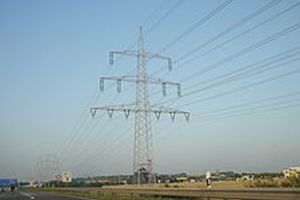The Israel Electric Corporation has begun to demand compensation for electricity sent into Palestinian areas, indicating the misgivings that Israelis feel over it.
 Gaza City, March 4 – The residents of this crowded city live under the constant stream of potentially fatal currents overhead, as Israel streams more than 120 megawatts of electric power into the coastal territory each day.
Gaza City, March 4 – The residents of this crowded city live under the constant stream of potentially fatal currents overhead, as Israel streams more than 120 megawatts of electric power into the coastal territory each day.
Electricity causes tens of thousands of deaths per year worldwide, and hospitals treat many times that number for injuries resulting from excessive exposure to electricity. The volume of electricity pumped by Israel into the Gaza Strip far exceeds the human body’s capacity to handle, a phenomenon closely associated with burns, nervous disorders, chronic pain, and other manifestations of injury and disrupted physiology even if death does not immediately result.
At present Israel sends the deadly energy into Gaza for up to six hours each day, but until recently the flow of the hazardous current was constant. During last summer’s war between Israel and Hamas, a number of Palestinian rockets hit and damaged the power lines Israel uses to send deadly electricity into the crowded territory, temporarily limiting Israel’s capacity to continue the practice. Although that capability has been restored, various political factors have since since spared Gazans the ordeal of a constant stream of dangerous electric current from Israel. One of those factors was the war itself, a fifty-day exchange of blows that left thousands of Gaza structures destroyed – many of which had been instrumental in carrying the deadly electricity throughout the heavily populated area.
Reliable statistics on the number of Gaza Strip residents killed or injured annually by electricity are unavailable; the Hamas-run Ministry of Health often conceals the true nature of many deaths in keeping with its propaganda goals, such that an electrocution victim might easily be listed as a casualty of an Israeli sniper attack. United Nations health officials, however, estimate that several dozen people are electrocuted in Gaza each year, a statistic that illustrates the clear and present danger Israel’s policy creates for the territory’s 1.4 million inhabitants.
The disproportionate nature of the Israeli-Palestinian relationship is manifest in this dynamic as well. While the Gaza Strip has the capacity to generate electricity and send it into Israeli civilian areas, the cross-border electrical infrastructure is built and maintained by Israel, which effectively blocks reciprocal jolts of electricity from Gaza. Israeli officials have accused Hamas of investing in combat operations and infrastructure instead of in civilian infrastructure, even as Israel continues to pump electricity in the other direction with seeming impunity.
Within Israel the parties involved have objected to the practice, though the reasons they cite do not explicitly include the physical danger it poses to Gaza residents. The Israel Electric Corporation has begun to demand compensation for electricity sent into Palestinian areas, indicating the misgivings that Israelis feel over it.
Earlier this year UN environmental officials warned of the waves that lap Gaza’s shoreline as a result of Israeli patrol craft. Over time, say the officials, waves erode the coast, further reducing the area available for habitat. If left unchecked, the waves from Israeli naval vessels will erode the entire Gaza Strip in as little as 24 million years, further exacerbating the territory’s acute housing crisis.




